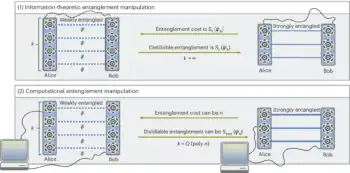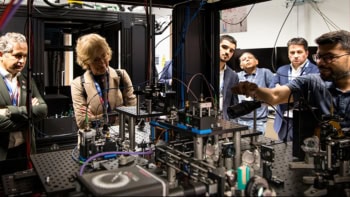Two of the most remarkable properties of light – squeezing and solitons – are being combined in a new generation of experiments that could revolutionize optics and communications.
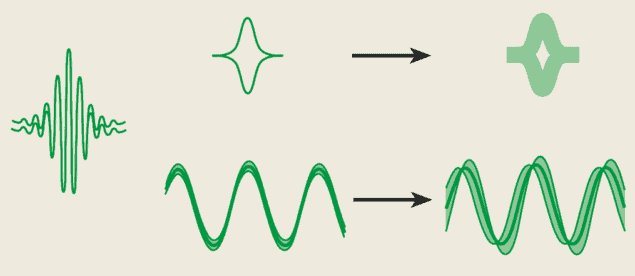
One of the most remarkable sights over Europe in the spring is the migration of large groups of birds from the south. Each group is composed of individuals of different strengths and speeds yet, thanks to an aerodynamic trick, they manage to move together as a group. The trick is to fly in a tight V-shaped formation in which the strongest and fastest birds stay at the front. These birds take the brunt of the air resistance, which slows them down. The weaker birds fly behind the leaders, taking advantage of the low-pressure region behind the stronger birds. This allows the weaker birds to move faster and with less effort. The overall result is that the group moves as a whole without dispersing, held together by air pressure at a uniform velocity.
A similar trick can be played by photons as they travel over intercontinental distances in optical fibres. In these systems, photons can fly in special bell-shaped pulses known as solitons. Solitons rely on the fact that the refractive index of the fibre – which determines, among other things, how fast light can travel in the fibre – depends on both wavelength and intensity.
Each pulse is composed of photons of different wavelengths. These wavelengths travel at slightly different speeds because the refractive index of the fibre decreases with wavelength at the infrared wavelengths used in fibre communications. This chromatic dispersion produces a “chirp” – blue wavelengths travel faster and move to the leading edge of the pulse, while longer red wavelengths travel slightly slower and stay at the trailing edge. Ultimately this chirp causes the pulse to spread.
Like the migrating birds, however, the photons can exploit another effect – in this case the nonlinearity of the fibre. This results from the fact that a small fraction of the refractive index depends on the intensity of the light travelling through the fibre. The fibre nonlinearity means that the peak of the soliton pulse experiences a higher refractive index than the rest of the pulse and is therefore delayed with respect to the “wings”. This produces a chirp that opposes that caused by the dispersion in the fibre. Thus the variation of the refractive index with both wavelength and intensity keeps the pulse together. This delicate balance between chromatic dispersion and the nonlinearity of the fibre occurs for pulses with a very specific shape (see box “The basics of solitons”).
Thanks to the compensation of chromatic dispersion by the fibre nonlinearity, soliton pulses can travel thousands of kilometres without changing their shape, provided that they are periodically re-injected with energy to compensate for losses. In optical communications systems this energy is supplied by erbium-doped fibre amplifiers that are spaced every 50-100 kilometres or so along the fibre.
The basics of solitons
Solitons rely on two properties of an optical fibre – its chromatic dispersion and its nonlinearity – cancelling each other out. When a pulse of duration T0 travels through an optical fibre, chromatic dispersion causes the duration to increase by a factor of √2 after it has propagated over a characteristic length, LD = T02/β2, where β2 is the coefficient of dispersion. For infrared pulses with durations of a few tens of picoseconds travelling in a typical communication fibre, the characteristic dispersion length, LD, is generally between 50 and 250 kilometres.
Similarly, when a pulse of peak power P1 travels through a fibre, the nonlinearity causes the phase of the peak of the pulse to be retarded by one radian after the pulse has propagated over a characteristic length, LNL = 1/γP1 where γ is the nonlinear refractive-index parameter.
If we have a pulse with a peak power P1 = β2/γT02). and an intensity profile of the form l(t) = P1/cosh(t/T0), the characteristic lengths for the dispersion and the nonlinearity are the same, LNL = LD, and the two effects will cancel each other. This means that the pulse can propagate in the fibre without changing its shape. Such a pulse is called a “soliton”.
A typical soliton contains a few hundred thousand photons. Solitons can be generated directly by fibre lasers, which naturally produce pulses of the right shape. Alternatively, if a pulse with a slightly different shape is introduced into the fibre, it will shed any excess energy and take up the correct shape for a soliton after having travelled for a few characteristic dispersion
Quantum noise
The capacity to travel without spreading, especially over long distances, has made solitons prime candidates for transmitting information. However, reaching the destination in good shape is no guarantee that information is transmitted faithfully because, in addition to any spreading of the pulse, the information has to fight against noise. Most of the noise is usually due to technical imperfections, such as random strains in the fibre or fluctuations in the lasers generating the pulses, and can generally be eliminated by improving the components in the system. But there is also a fundamental and unavoidable source of noise that cannot be eliminated by technical improvements: this is the noise due to the quantum mechanical nature of light.
Quantum noise is a consequence of the uncertainty principle, and arises because there is a quantum mechanical “incompatibility” between the generation and the detection processes for light pulses. Solitons are made of coherent light, which is the “purest” light that a laser can deliver. The electric field of a coherent state has a non-zero expectation value that oscillates sinusoidally in time, just like a classical oscillating field.
The detection of solitons is performed by a photodiode. This device measures energy and therefore essentially counts the number of photons, N, in the soliton. The quantum eigenstates associated with these eigenvalues are called number states. However, a coherent state is not an eigenstate of the photon-number operator and must therefore be expressed as a superposition of all possible photon-number states. This means that when a coherent soliton pulse is detected, the most likely outcome of the measurement will be N but, in general, a different result will be obtained each time a measurement is made. This uncertainty in the values measured in such experiments is often referred to as quantum noise.
Quantum noise is usually illustrated by making the classical picture of the field “fuzzy” to an extent prescribed by the Heisenberg uncertainty principle. For example, a coherent soliton can be represented as a superposition of a classical hyperbolic secant (I(t) = P1/cosh(t/T0)) light pulse and the quantum fluctuations of the field (figure 1).
Clearly, this “noise” does not arise from any technical imperfection of the instrumentation, but is simply due to the fact that laser emission and light detection involve two different observables – the amplitude of the electric field and the energy of the pulse – that do not have common eigenstates. The noise power level in such a measurement is proportional to the variance of the photon-number distribution. Since this distribution obeys Poisson statistics for a coherent state, the noise power level is proportional to N , the mean number of photons in the pulse. The particular noise power level associated with a coherent state is also known as the “shot noise” (figure 2).
The quest to reduce the quantum noise in solitons has been going on for about a decade, based on ideas proposed by Marc Levenson, then at the IBM Almaden Research Centre in San Jose, California. Levenson’s ideas were further developed by Herrmann Haus of the Massachusetts Institute of Technology (MIT) in the US and by Peter Drummond of the University of Queensland in Australia.
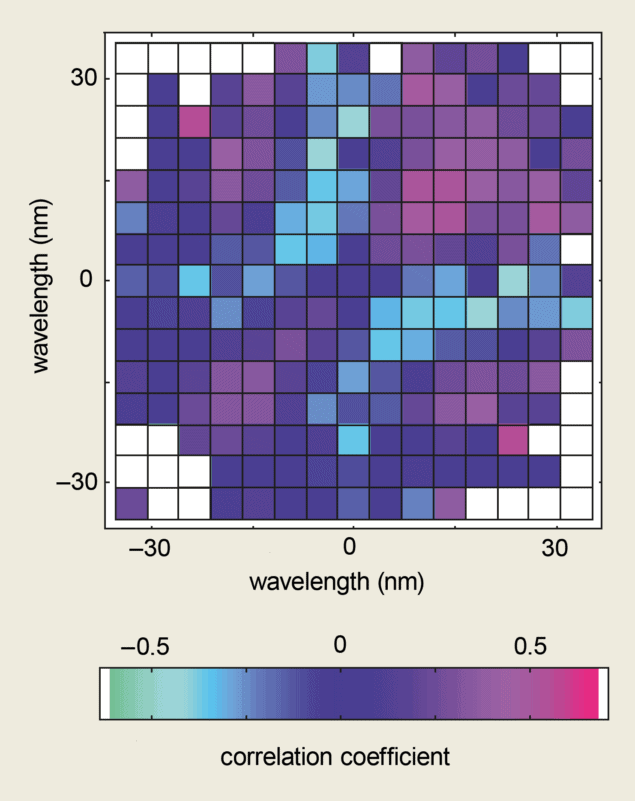
These ideas were based on the concept of “squeezing”, which is closely linked to the uncertainty principle. Consider, for example, the uncertainty relationship between position, x, and momentum, p. According to the uncertainty principle, DxDp >= h/2, where Dx and Dp are the uncertainties in position and momentum, and h is the Planck constant. A similar relationship exists between the photon number, n, and phase, f, in an electromagnetic field. In this case the uncertainty relation can be written roughly in “shot-noise units” as DnDf >= 1.
When the equality sign holds in the Heisenberg relation – for example Dx Dp = h /2 – we have a “minimum-uncertainty state” that does not have any excess noise. A coherent state is a very special kind of minimum-uncertainty state in which the uncertainties in any pair of “conjugate” variables are equal (e.g. Dn = Df = 1). The basic idea behind squeezing is that it is possible to construct other kinds of minimum-uncertainty states by reducing the uncertainty in one variable at the expense of increasing the uncertainty in the other variable, while still satisfying the equality (e.g. Dn < 1 and Df > 1, but Dn Df = 1). Squeezing was achieved in the laboratory for the first time in 1985 by Dick Slusher and co-workers at Bell Labs in the US, and since then a large number of squeezing experiments on different aspects of the electromagnetic field have been reported.
The first experimental demonstration of soliton squeezing was reported by Michael Rosenbluh and Bob Shelby at IBM in San Jose in 1991. Rosenbluh and Shelby did not squeeze the photon number but rather the so-called in-phase quadrature of the soliton: this is the sine or cosine component of the soliton and it can be measured by combining the soliton with a stronger reference beam known as a “local oscillator” in an interference experiment. This early work was followed up by groups in other US laboratories, notably those of Erich Ippen at MIT and Keren Bergman at Princeton University.
In 1996 Stephen Friberg’s group at the NTT Basic Research Laboratories in Japan squeezed the intensity (i.e. the photon number) of a soliton to 60% of the shot-noise level. Friberg and co-workers started with a pulse that contained slightly more energy than a fundamental soliton and then filtered away some of its spectral components to produce a squeezed soliton.
Recently a group led by Gerd Leuchs and Andreas Sizmann of the University of Erlangen-Nurnberg in Germany announced that it had squeezed the photon number of a soliton pulse even further – to 30% of the shot-noise level. In addition to being the current record for soliton squeezing, this feat was achieved with a simpler experimental set-up than that used at the NTT. Ultimately it should be possible to squeeze solitons to below 10% of the shot-noise level.
Inside the soliton
The main physical feature that makes soliton squeezing possible is the fibre nonlinearity. Indeed, in addition to serving as the “glue” that keeps the soliton together in the face of dispersion, the nonlinear interaction among the photons imparts quantum correlations that make the fluctuations of an observable in any two wavepackets in the soliton vary in unison, even though each individual wavepacket varies at random.
One way of understanding this is to view the nonlinear interaction among photons as a process in which pairs of photons annihilate each other to create a virtual state of polarization in the fibre. This virtual polarization disappears immediately to produce a pair of “twin” photons whose fluctuations are correlated. This process creates a “brotherly bond” among the photons that helps structure the soliton, and this persists even as the individual photons merge into the large crowd of other photons – just as family ties underlie the internal structure of migrating flocks of birds and persist for as long as each bird lives.
These quantum correlations have been demonstrated in recent experiments in Erlangen. Leuchs, Sizmann and co-workers “sliced” a soliton into 15 spectral intervals and measured correlation functions for the intensity fluctuations between pairs of these intervals. They measured all 105 pair correlation functions to construct a map of the intra-pulse quantum correlations (figure 2). This map showed that the photon-number fluctuations of the different spectral components of the soliton are very strongly correlated or anti-correlated (i.e. they either vary together in the same sense or in the opposite sense), as if they consisted of “twins”. These experiments reveal one aspect of the intricate internal quantum structure of optical solitons that is at the root of squeezing. Armed with this knowledge the Erlangen group was able to reduce the noise power in a soliton to 30% of the shot-noise level.
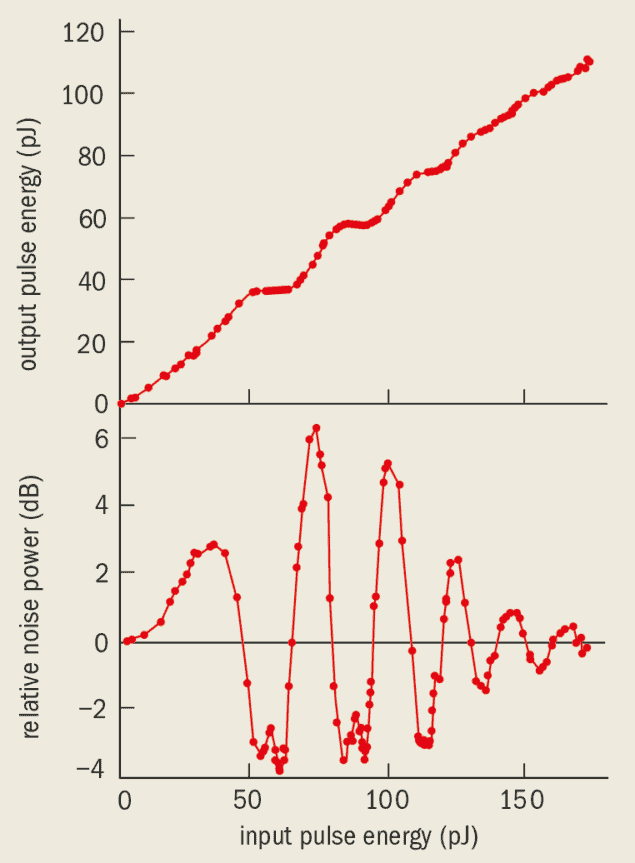
Leuchs and colleagues used a fibre-loop interferometer in which the soliton is split asymmetrically (90/10) into two replicas that interfere with each other at the exit of the loop. The input-output characteristic curve of the loop displays several plateaus – regions for which the energy of the output pulse is almost independent of the input pulse energy. The interferometer therefore acts as an “optical limiter”, producing pulses with a stabilized energy content.
The Erlangen group measured the quantum noise of these stabilized pulses by detecting them with a pair of photodiodes and looking at the fluctuations of the overall photocurrent at a frequency of 20 MHz. There should not be any signal or any technical noise in this frequency range, so any fluctuations observed can be attributed to the quantum noise of the detected pulses. The team found a noise level that was significantly lower than the shot-noise limit, indicating that the stabilization involved not only the mean pulse energy but also its quantum fluctuations (figures 3 and 4).
This experiment is striking for two reasons. First, it produced a high level of squeezing. Second, the experiment used run-of-the-mill fibre technology, which means that a device for squeezing solitons could be readily incorporated into a real fibre communications system.
The special stabilizing properties of asymmetric interferometers have been discussed by many theorists, including Yoshi Yamamoto of Stanford University in California, Akira Hasegawa of Osaka University in Japan and Nick Doran of Aston University in the UK, over the past 10 years. However, the Erlangen experiment is the first clear-cut demonstration of these stabilizing properties. Mike Werner of NTT in Japan has independently proposed the use of asymmetric interferometers to achieve many different types of soliton squeezing.
Solitons in action
Mastering the physics of the nonlinear refractive index of the fibre has been crucial for the development of high-bit-rate long-haul transmissions. Taking advantage of the fibre nonlinearity has produced a definite niche in transoceanic fibre communications for soliton-like pulses, even though the distinction between soliton and non-soliton pulses becomes blurred at high bit rates where nonlinear effects are important for all types of pulses (see Doran and Bennion in further reading). And although our understanding of the subtle interplay between the nonlinear interactions and the quantum fluctuations has not yet reached the stage where it can pass from research to development, we can already envisage potential areas of applications for the squeezed solitons.
In all these applications one has to bear in mind that squeezing is very fragile, and that the carefully tailored distribution of photons in the squeezed soliton goes back to the shot-noise level as losses gradually remove photons from the soliton pulse at random. However, even if the squeezing of solitons cannot survive for more than a dozen kilometres of propagation, it can be extremely valuable when it is alive.

One area of application concerns the transmission and processing of classical (binary) information, in which the presence or absence of a soliton in a time-window corresponds to a “1” or “0”, as in traditional optical-fibre communications. However, since solitons occur at fixed power levels, we do not have the luxury of being able to crank up the input power to improve the signal-to-noise ratio at the receiving end. Nevertheless, the exploitation of quantum effects such as squeezing could help to reduce noise and improve fidelity.
In long-distance communications, where the signal is amplified every 50-100 kilometres or so, the soliton pulse is strongest just after the amplifier. Luckily this is where the bulk of the nonlinear interaction needed to maintain the soliton shape occurs. However, the pulse gets weaker as it propagates along the fibre, so the nonlinear interaction also becomes weaker and weaker. This means that dispersive effects become dominant until the next stage of amplification, where the nonlinearity takes over again. One problem is that quantum fluctuations in the amplifiers lead to random jumps in the central wavelength of the individual solitons, and this results in a random variation of the speed of individual solitons in the fibre.
Several schemes have been devised to remove this excess noise and bring the train of solitons back to the orderly behaviour characteristic of a stable coherent state (e.g. the solitons could be passed through a spectral filter). Photon-number squeezing could also play a key role in solving this problem. For example, if the solitons are number-squeezed immediately after amplification, there will be a smaller uncertainty in the nonlinearity that keeps the soliton in shape and, therefore, there will also be less noise in the soliton. This results in an improvement in the bit-error rate of the transmission. The fact that squeezing does not survive attenuation does not matter in this case, since it is alive during the nonlinear interaction – when it is needed.
Another possible application of squeezed solitons would be in switching devices and logic gates based on soliton interactions, such as the fibre-end devices for signal processing in telecommunications developed by Mohamed Islam at AT&T in the US in the early 1990s. The use of number-squeezing would allow collisions between solitons to be controlled to high precision, thus significantly reducing the error rate of these devices.
What is shot noise?
Shot noise is the noise power level associated with a coherent state. As explained in the text, a coherent state, |α⟩,can be expressed as a superposition of all possible photon “number states”, |n⟩, as |α⟩ = exp(–1/2|α|2)Σ(αn/√n!)|n⟩ where |n⟩ is a number state containing n photons, and N = |α|2 is the nominal number of photons in the pulse.
The photodiodes used to detect solitons essentially count the number of photons in the soliton. For a coherent state, the photon-number distribution measured by the photodiode follows Poisson statistics, Pn = exp(–|α|2)(α/n!). The noise level of any state is defined as the variance of the photon-number distribution.
A property of Poisson distributions is that the variance is equal to the mean. Therefore, the noise level associated with any pulse obeying Poisson statistics is simply N, the mean number of photons contained in the pulse. However, techniques such as squeezing allow many of the limitations imposed by this fundamental quantum noise to be overcome.
Solitons and quantum information
It might also be possible to use solitons in the processing of quantum information. Quantum information is an emerging field of physics that takes advantage of phenomena that are particular to quantum mechanics – such as uncertainty, superposition and entanglement – to code, transmit or process information (see Physics World March 1998). Recent highlights in this field include quantum cryptography (which can be used to achieve unconditionally secure key distribution) and quantum computing, which considerably speeds up the solution of problems that are exponentially difficult. These problems include the factorization of large numbers and searches of large databases.
Although most proposals for processing quantum information to date concentrate on single-photon or single-spin implementations, optical solitons may offer an alternative that is easier to handle experimentally, yet still provides many of the basic quantum features that are displayed by single quanta. This could lead to new paradigms for computation and communications. In particular, the existence of quantum correlations in the fluctuations of the spectral and temporal sidebands of the solitons turns them into macroscopic quantum objects with internal entanglement. If these internal quantum correlations can be tailored into prescribed patterns, it might be possible to use solitons as “quantum signatures” and have completely secure transmissions.
Another interesting feature is that the interaction of two solitons puts them into an “entangled” state in which quantum mechanical correlations (“brotherly bonds”) exist between two spatially separated objects. This has already been exploited for quantum non-demolition measurements by Friberg’s group at NTT, and could also possibly lead to quantum devices such as “controlled-NOT” gates. These gates form the basis of quantum computing.
The possibilities that are opened up by the quantum mechanical nature of the optical soliton, and by the exploitation of the brotherly bonds that exist among its photons, are vast but still too early to assess. We can expect, nevertheless, that the research on the quantum properties of solitons will have a large impact on information transmission and processing – just as an understanding of the family structure and sociology of migrating birds gave man the idea to use homing pigeons to carry messages. Indeed, this was the basis of long-distance high-speed information transmission from the time Noah set foot on dry land until radio waves took over, four millennia later.


